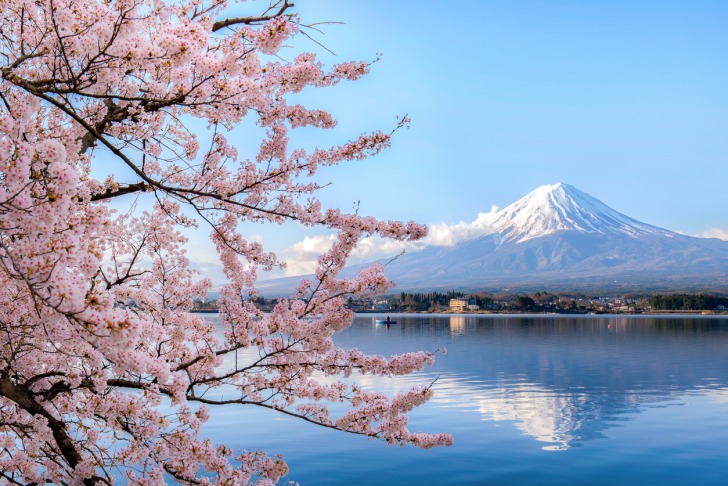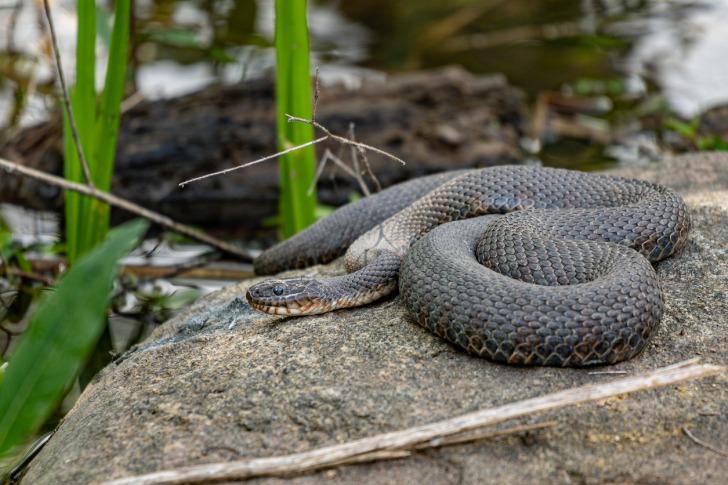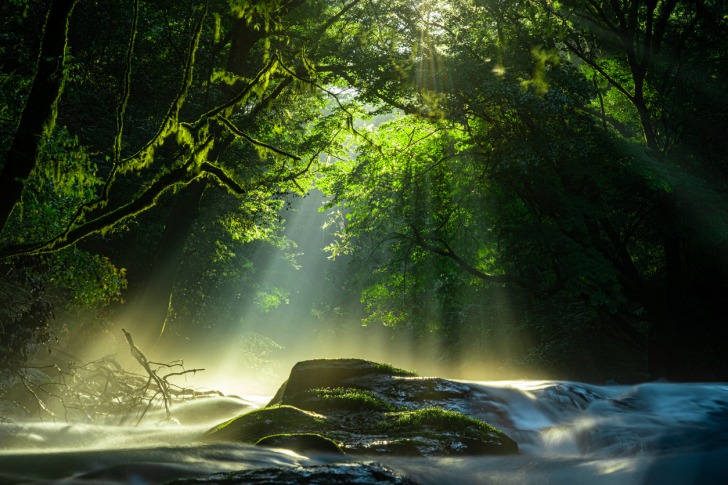Japan is a popular destination for tourists.
It’s known as the land of cherry blossoms because it has more than 200 species of these fragrant beauties.
Along with cherry blossoms, it also has its fair share of snakes.

Contents
So… Are There Snakes in Japan?
Japan is a collection of islands, so you may be surprised to learn that there are plenty of snakes that call the country home.
Yes, Japan has snakes.
47 different species call the country home.
Four of these species are highly venomous, so you’ll need to use caution when traveling in Japan.
Japan is home to a wide variety of snakes, thanks to its different climates and ecosystems.
These include tropical, subtropical, and temperate forests, grasslands, wetlands, and coastal areas.
Snake Species in Japan
Mamushi
Let’s start with Japan’s most dangerous snake, the Mamushi.
It’s a type of pit viper, and it’s responsible for 2,000 to 3,000 bites each year, and about 10 deaths.
It’s found throughout Japan, except for the Ryukyu Islands.
The body of the snake can be gray, reddish brown, or tan.
It has blotches that are outlined in black with light-colored centers.
Protobothrops elegans (Habu)
There are three native species of Habu found in Japan.
The most venomous is the Okinawan habu.
It’s also the largest and can reach 8 feet in length.
The Taiwan Habu is an invasive species that also lives in Japan.
Habus bites about 91 people each year, but fatalities are rare.
They have a patterned body, which can be brown or gray with black spots.
Tiger Keelback
The Tiger Keelback is a large snake, reaching about 5 feet in length.
Their body is brown or olive colored, with beautiful orange sides.
They also have small black spots on their body, which gives them their name.
The keelback is venomous, but bites are rare.
In the last 100 years, there have only been 29 bites by the keelback.
Fatalities are very rare, and antivenom is available.
It’s difficult for them to bite humans because they have rear fangs.
They aren’t aggressive, and most bites happen when someone picks up the snake.
They prefer areas near water, and they are great swimmers.
Japanese Coral Snake
The Japanese coral snake, also called hyan, is another venomous species in Japan.
While it is dangerous, it has short fangs that make it difficult to inject humans fully.
These snakes are rare and are currently endangered.
They have a red body with black stripes.
Their striking appearance makes them easy to identify.
Sea Snakes
Sea snakes are highly venomous, but they rarely bite.
They make their home in the sea and are considered a delicacy by many.
The black-banded sea krait is the most well-known and feared sea snake in Japan.
It has a light-colored body with black bands.
Others include the yellow-lipped sea krait and the yellow-bellied sea snake.
Is it Safe to Go on a Trek in Japan?
Generally, Japan is safe to explore.
However, there are dangers that you should be aware of before you travel there.
Natural Disasters
Japan is part of the Pacific Ring of Fire.
This means it has active volcanoes.
It’s also prone to earthquakes.
Typhoons are another risk, especially in the island areas.
Snowstorms also pose a risk.
Many travelers are injured in snowboarding or ski accidents each year.
Wildlife
We know Japan has a few snakes that you should beware of.
The Habu is located in the southwestern islands of Japan, while the Mamushi is common in mainland Japan.
Bears and wild boar are some of the largest animals that you should be aware of.
Giant centipedes and the Denki mushi can certainly ruin your day and may require medical attention.
The Asian giant hornet is one of the most dangerous creatures in Japan.
It has caused deaths due to its highly potent venom, even in people who aren’t allergic to it.
The waters of Japan also harbor dangers.
These include pufferfish and jellyfish, in addition to sea snakes.
Interesting Snake Facts in Japan
Japan has 47 different species of snakes, and four species pose a risk to humans.
The Japanese rat snake is the most common.
Its pattern mimics the mamuchi, which encourages people and predators to steer clear of it.
The rat snake is harmless, but it uses this pattern as a way of protecting itself.
A city in Japan, Chugoku, has the honor of being the only area with a population of albino rat snakes.
These snakes are completely white because their body doesn’t produce pigment.
Japanese people consider snakes to represent good luck, particularly in business.
They are associated with regeneration, rebirth, and youth as well.
In Japanese mythology, Uwabami are giant snakes.
They consume large amounts of food and sake or Japanese liquor.
They are also known to eat humans occasionally.

3 Safety Tips for Exploring Nature in Japan
1. Know Where You Are and How to Get Back
40% of emergencies in Japan’s wilderness are caused by someone getting lost.
Trails and routes are often marked by signs in Japanese, so it’s easy for tourists to get lost.
Be sure that you have a reliable map and compass, or a GPS device that functions in Japan.
2. Be Prepared for the Weather
There are a few hypothermia or cold, deaths in Japan each summer.
The temperatures in the mountains can go from balmy to freezing in less than an hour.
This means if you are exploring these areas, you’ll need to be fully prepared for freezing or rainy weather.
3. Let Wild Animals Be Wild
There are plenty of wild animals in Japan.
These include monkeys, bears, and boar.
If you encounter a wild animal, don’t approach it.
If you accidentally stumble on a snake or other creature, back away slowly.
Never feed wild animals.
This can cause them to lose their natural fear of humans and can affect their health as well.
Summary
Japan is home to four species of venomous snake, with the Mamushi and Habu being of the greatest concern.
Snake bites are uncommon.
There are about 3,000 bites each year.
This may sound like a high number, but it’s important to realize Japan has nearly 130 million people.
This means your odds of being bitten by a snake are extremely low.
Japan Safety Overview
READ THE FULL REPORT: Japan Safety Review
Safety Index:
- OVERALL RISK: LOW
- TRANSPORT & TAXIS RISK: LOW
- PICKPOCKETS RISK: LOW
- NATURAL DISASTERS RISK: LOW
- MUGGING RISK: MEDIUM
- TERRORISM RISK: MEDIUM
- SCAMS RISK: LOW
- WOMEN TRAVELERS RISK: LOW
Frequently Asked Questions
Are snakes feared in Japan?
In Japan, snakes are often honored.
They are considered Gods or a messenger of the Gods.
There’s a belief that harming a snake can bring a curse from the Gods.
Are snakes everywhere in Japan?
Japan has several different ecosystems, and all of them have snakes.
Nearly every area of Japan has at least one species of venomous snake as well.
What do snakes eat in Japan?
Some Japanese snakes, including the Japanese rat snake, have birds at the top of their menu.
They can even climb trees to raid bird nests.
Other snakes prefer frogs, and some munch on lizards, mice, and other small rodents.
Are white snakes sacred in Japan?
Snakes are considered sacred in Japan, but white snakes are special.
Some areas believe they are messengers of the God Benzaiten.
In other areas, they are associated with fortune or water Gods.











